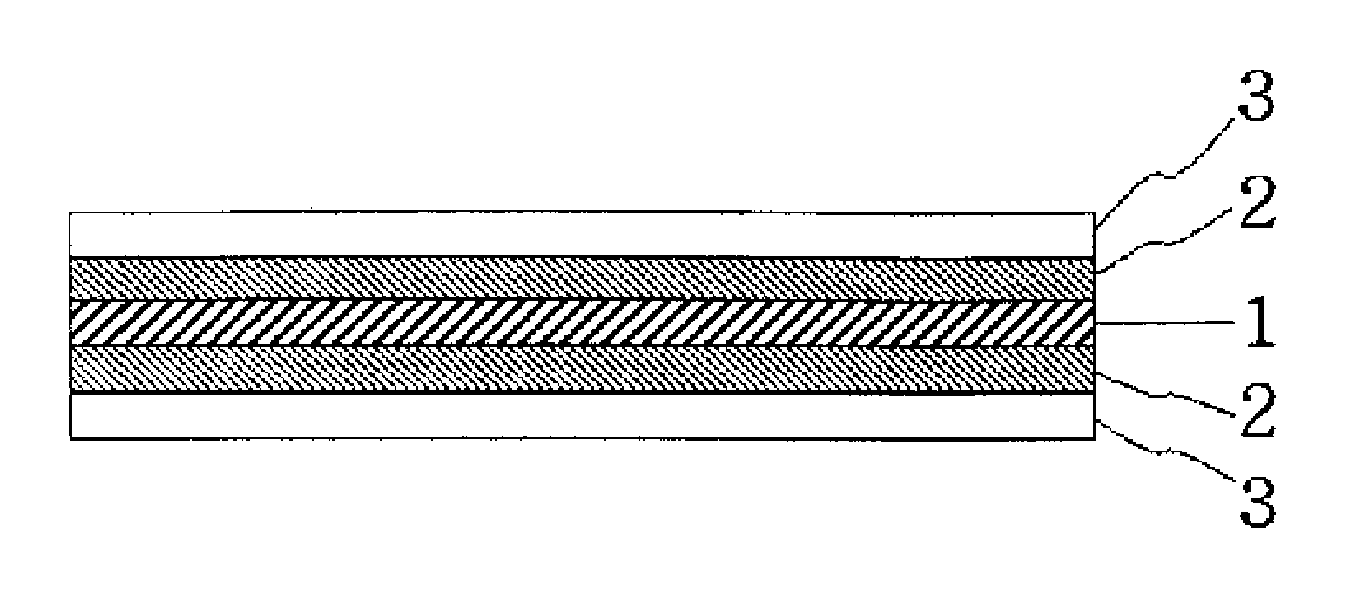Heat sink sheet including an adhesive having good heat conductivity
a technology of heat conductivity and sink sheet, which is applied in the direction of film/foil adhesives, semiconductor/solid-state device details, electrical products, etc., can solve the problems of afterimage and system stability, reduce the lifespan of a product, and reduce the manufacturing cost of a product, so as to increase the production yield of the product, reduce the manufacturing cost, and the manufacturing process is simple
- Summary
- Abstract
- Description
- Claims
- Application Information
AI Technical Summary
Benefits of technology
Problems solved by technology
Method used
Image
Examples
example 1
Preparation of a Thermally-Conductive Adhesive
a) Carbon Nanotube-Dispersed Solution
[0045]5 g of single-wall carbon nanotubes were surface-treated with 500 mL of 2N acetic acid. Subsequently, 0.3 wt % of polyvinyl pyrrolidone was mixed with 2 wt % of the surface-treated carbon nanotubes, 98 wt % of isopropyl alcohol and 100 wt % of a solvent to form a mixed solution, and then the mixed solution was irradiated with ultrasonic waves of 300˜400 W / cm2 for 5 hours to disperse the carbon nanotubes in the mixed solution, thereby preparing a carbon nanotube-dispersed solution.
[0046]21.55 wt % of 2-ethylhexyl acrylate, 13.71 wt % of n-butyl acrylate, 1.57 wt % of 2-hydroxymethyl acrylate, 0.39 wt % of 3-methacryloxypropylmethoxysilane, 0.08 wt % of 2,2′-azobisisobutyronitrille as a polymerization initiator, 39.18 wt % of ethyl acetate, and 23.52 wt % of toluene were put into a four-neck flask provided with a stirrer, a thermometer, a nitrogen gas supply pipe and a cooler, a...
example 2
Preparation of a Thermally-Conductive Adhesive
[0048]A thermally-conductive adhesive was prepared in the same manner as in Example 1, except that double-walled carbon nanotubes were used.
example 3
Manufacture of a Heat Sink Sheet
[0049]The thermally-conductive adhesive obtained in Example 1 was applied onto both sides of a graphite sheet having a thickness of 0.2 mm, a size of 300 mm×300 mm, a carbon content of 99.5% and a thermal conductivity of 5.5 w / m·k (thickness direction) using transfer coating such that the thickness of the applied thermally-conductive film is 25 μm, thereby manufacturing a heat sink sheet.
PUM
| Property | Measurement | Unit |
|---|---|---|
| particle size | aaaaa | aaaaa |
| thermal conductivity | aaaaa | aaaaa |
| temperature | aaaaa | aaaaa |
Abstract
Description
Claims
Application Information
 Login to View More
Login to View More - R&D
- Intellectual Property
- Life Sciences
- Materials
- Tech Scout
- Unparalleled Data Quality
- Higher Quality Content
- 60% Fewer Hallucinations
Browse by: Latest US Patents, China's latest patents, Technical Efficacy Thesaurus, Application Domain, Technology Topic, Popular Technical Reports.
© 2025 PatSnap. All rights reserved.Legal|Privacy policy|Modern Slavery Act Transparency Statement|Sitemap|About US| Contact US: help@patsnap.com


